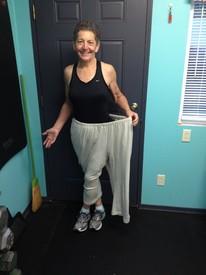Give me tips for portion control
Options

Anita4548
Posts: 39 Member
How did you learn to eat smaller portions? Does it become a habit?
When I went vegan, I started eating enormous amounts of food. How silly was I, watching all the high carb low fat youtubers eating huge bowls of rice and veg thinking oh its good food I wont put on weight!?
Anyway, what are your tips for eating smaller portions? ATM I am trying to eat low cal salads i.e. no dressing in addition to whatever I am having for dinner just so I can feel full but I really want to be able to eat smaller portions. I've been logging my food for a month and a half now and I do eat less but I still WANT to eat more.
I feel like it's really difficult to eat small portions when you are surrounded by restaurants and take aways and even supermarket portions that are big enough to feed a family
When I went vegan, I started eating enormous amounts of food. How silly was I, watching all the high carb low fat youtubers eating huge bowls of rice and veg thinking oh its good food I wont put on weight!?
Anyway, what are your tips for eating smaller portions? ATM I am trying to eat low cal salads i.e. no dressing in addition to whatever I am having for dinner just so I can feel full but I really want to be able to eat smaller portions. I've been logging my food for a month and a half now and I do eat less but I still WANT to eat more.
I feel like it's really difficult to eat small portions when you are surrounded by restaurants and take aways and even supermarket portions that are big enough to feed a family
2
Replies
-
Pre log your day to see what you can eat to meet your calories and macros?9
-
It’s about learning self control8
-
If you go out to eat get a to go box and put away half the food before you start to eat4
-
I think we’re always going to be surrounded by portions that are way larger than what we know is reasonable, so it’s mostly a matter of forcing yourself to change your habits consistently, with the hope of eventually changing your mindset, satiety, and satisfaction with smaller portions. Fake it til you make it!2
-
setting boundaries with yourself. Say No, this is enough. I love myself, I want to look good! Then drink some water.4
-
I meal prep and put things into their own containers so I can just grab a perfectly portion lunch or for dinner, I have how much a portion weighs written on the container and I weigh out exactly that much. Sometimes I'm hungry in between meals and it makes me evaluate if I didn't eat enough, my macros are off, OR if I'm just bored and not actually hungry. But the meal prepping has saved me or I would just come home and eat tortilla chips out of the bag and call it dinner11
-
I meal prep and put things into their own containers so I can just grab a perfectly portion lunch or for dinner, I have how much a portion weighs written on the container and I weigh out exactly that much. Sometimes I'm hungry in between meals and it makes me evaluate if I didn't eat enough, my macros are off, OR if I'm just bored and not actually hungry. But the meal prepping has saved me or I would just come home and eat tortilla chips out of the bag and call it dinner
Yes! Planning what you’re going to eat for the day is absolutely key to better portion control. If you’re deciding ahead of time how much you will need to eat during the day, instead of deciding during your hungry-moments, you’re more likely to make good portion decisions.
2 -
I’ve been at this 7 years. I’m not satisfied with smaller portions and don’t expect that I ever will be.
Being hungry 24/7/365 isn’t really a sustainable option for me, so I eat more quantity of foods that are high volume and low calorie, and less quantity of foods that are low volume and high calorie.
I’m not satiated by protein or fat. I am satiated by volume (and fiber-which conveniently comes as part of many foods that are high volume and low calorie).
Some people are satisfied with a playing deck sized portion of meat and 1/2 cup of vegetables as a meal. Some people who find protein and fat satiating can eat be satiated by eating smaller portions of higher fat/protein foods. Some of the rest of us need a certain volume of food.
I would suggest playing around with various macros to see if that helps. Many people are satiated by protein and fat. So adding some oil to your salad dressing, or some seitan or something in place of some rice may help? Some people find fiber helps as well. Maybe add more beans/lentils?
If nothing really helps and you don’t find any improvement over time, you may also just be someone who is not satisfied with smaller portions.9 -
It's easy when meal prepping for yourself because you can measure everything, portion it out, put it away. When eating out, I used to just ask for a box and put half my dinner in it. There are lower calorie option at some restaurants, or you can order salad instead of sides. Learning ways to order healthier options helps too. You sometimes just have to practice eating less until you get used to it.3
-
I eat larger portions and fit them into my calorie targets. My lunch's are the biggest meal of the day and it usually includes mixing-bowl sized salads, or stirfrys with a serving of rice and then an entire bag of steamer veggies plus shrimp or beans etc. These are my meals though, not a side.
Maybe instead of having a plain (ie boring) salad as a side to a meal-make it a large, fun (ie lots of variety in it) salad and have it as your meal. You can add 3-4 ounces of protein to your salads for around 100 calories and then the rest be veggies, low calorie dressing/salsa, low calorie toppings etc. I think a lot of us grew up where veggies were a side dish-make them the focus of your plate and you can have all sorts of interesting, tasty meals that also have a lot of volume
4 -
i fill up on raw veggies a ton. but them up in slices/sticks so they take longer to eat.
but beside that i've had to pre-log and use a scale for everything. i drink a TON of carbonated no cal water and tea which helps keep me full.
beyond that it's mind over matter.2 -
Great ideas!!!0
-
Feeling satiated is a big one for me aka eating foods I like and not "feeling"deprived. I learned to eat the correct portions by weighing and measuring my food with a food scale in my calorie allowance. Nothing else much worked for me.1
-
I started by going by the recommended serving size for things that are not individual servings (weighed all solid and semi solid, measured liquids):
112g oz beef
58g sandwich meat
170g chicken breast
1 slice bread
112g yogurt
32g peanut butter
40g oats
32g butter
etc.
After I saw what a serving size was and where it fit into my macro mix and calorie goal I was able to increase if I wanted. Most I was able to eat what was recommended and just eat a wider variety of things.
1 -
Use smaller plates2
-
I like simplicity when it comes to losing weight, counting calories, weighing and prepping isn’t that for me. So little things I did when I went out to restaurants was asking for a container and putting some food away for later. I also used the smaller plate trick- that actually helped me to learn how to eat in moderation ( smaller portions compared to before).0
-
I still eat large amounts of food, I just make sure that at least half of my meal is vegetables. However, if there is no protein or fat present in that meal I will still be hungry soon afterwards.
Prelogging is great for keeping my calories in check. It is my best tool with both weight loss and maintenance. Knowing how much I can eat before I eat it is freeing in so many ways as it means I can enjoy the foods I want.1 -
How did you learn to eat smaller portions? Does it become a habit?
When I went vegan, I started eating enormous amounts of food. How silly was I, watching all the high carb low fat youtubers eating huge bowls of rice and veg thinking oh its good food I wont put on weight!?
Anyway, what are your tips for eating smaller portions? ATM I am trying to eat low cal salads i.e. no dressing in addition to whatever I am having for dinner just so I can feel full but I really want to be able to eat smaller portions. I've been logging my food for a month and a half now and I do eat less but I still WANT to eat more.
I feel like it's really difficult to eat small portions when you are surrounded by restaurants and take aways and even supermarket portions that are big enough to feed a family
I have bigger portions of low calorie foods like low cal salads and veggies, and smaller portions of calorie dense foods.
I'm an omnivore, but when I was in Costa Rica I ate mostly plant based, and found rice and beans super filling, and also ate a lot of fruit.
Yes, restaurant portions can be ridiculously large. I generally plan to eat half or less.3 -
In restaurants, divide your meal in half or 1/3-2/3 as soon as you receive it. Then eat only half or a third and ask for a take home box. I usually get at least 2 more meals out of the leftovers. Some people get a box as soon as it's served, but I haven't had many waitstaff actually do that.
On pasta, eat the protein and a small portion of pasta. Leave the rest if you can't take it with you. It will go either to waist or waste.2 -
Anita, I wonder if you would like trying out Japanese bento boxes for portion control for your meals on the go (school, work, etc.)? As others have already stated, meal prep is a big key to winning. Because you are vegan, I also wonder if some of the bento recipes (with focus on grains, proteins like tofu, and root vegetables) may appeal to you (while most Japanese eat fish, some are Buddhist and there is food designed around that). I don't know what your caloric needs are, but bento boxes are sized to hold X number of calories based on gender & age.
http://www.justbento.com/how-bento-lunches-helped-me-lose-30-lbs-so-far
https://ss-biggie.livejournal.com/29512.html1 -
It's about mindset and acceptance. I'm capable of eating more, and I will always want to do it. For some things it's possible for other things it isn't. It's just the reality of weight management that you could deploy a few strategies to come close to eating the way you want, but "free for all" will never be an option. You'll have to eventually accept that sometimes you'll have to say "no", "later", or modify your other foods/activity to fit something in.
My best portion control strategy is "the smallest satisfying amount". By satisfying, I don't mean just hunger, but mental satisfaction as well. I'm capable of eating 3 cups of rice and I would always have this tiny voice in my head telling me it would be awesome, but eating 300 grams of rice offers only marginal mental satisfaction over eating 150 grams. Being 98% satisfied is worth it. That 2% extra satisfaction is not worth doubling the calories.
Another portion control strategy I use, often in combination with the first, is bulking. Adding vegetables to pasta, for example, makes it look as large as I'm used to, but for fewer calories. I try to use spices and herbs to my advantage to pack as much flavor into things as possible so the experience of eating is pleasant despite not being able to eat large amounts of food.
To control portions, it doesn't need to be by size alone. There are things that just aren't mentally satisfying in smaller portions no matter what I do. For these things, I use "time spacing" as a portion control strategy. I just have them less often. Taking an extra 15 minute brisk walk for a couple of weeks allows me to plan something high in calories that I need in larger amounts to feel satisfied.7 -
Competeballpythons wrote: »Use smaller plates
^I do this, it is so simple yet so effective0 -
Feeling hungry all the time means you simply aren't getting enough food. Weight loss has to be a combination of exercise and calorie reduction.
Eating salad is great but you really need to add some fat and protein with it. Most people have the idea that losing weight should be fast and effective. It's not. It's a journey not a destination.
I too agree that adding more protein doesn't always work although it's supposed to keep you feeling fuller longer. I try adding things like broccoli or cauliflower to my meals. They have a good deal of fiber and water content and can fill you up quickly.
I find that 8 ounces of water before a meal can really help too when it comes to portion control. Having said that even though I try to do it, it doesn't always work.
Calorie reduction should really be secondary to exercise. Exercising more means you can eat more. You just have to find the balance.8 -
This content has been removed.
-
Try eating your measured portion, and then drink two big glasses of water. Or drink two big glasses of water 10 minutes before you eat. I get full quickly that way.1
-
One thing I always found is that fruits and veggies often do not make be feel full. It seems like I can eat a big salad, and then 60 minutes later, be ravenously hungry again. Try experimenting to find things that are low in calories, but leave you feeling fuller. For me, it's carbs.2
-
Fruits and veggies are carbs. Or did you mean grains?2
-
I didn't really think about portions per se. I logged, then used my food diary to look for foods that were costing me relatively many calories compared to the tastiness, satiation, and nutrition I got from them. I'd reduce or eliminate those, and include something else I liked that better helped me reach my goals. That gradually led to a more satisfying, nutritious way of eating.
Physical volume of food is one thing that helps me feel satiated, but lots of veggies (cooked or raw) usually ticks that box well for me. Personally, I also need adequate protein through the day in order to feel full, and I think it's important for nutrition/health to get a certain minimum amount of fats. So, it all needs to balance out within my calorie goal.
Now in year 3 of maintenance, I find - if I need to cut back a little - that I can fit in my basic nutrition in fewer calories now than when I started losing weight around 4 years ago, and I think the physical volume of food may be greater than those early stages at a reduced calorie goal. (I'm vegetarian, ovo-lacto not strict - not that that really makes a difference strategically IMO.)2 -
Things that worked for me: at home, I use a luncheon plate that's smaller than a dinner plate and load that up. It looks like a full plate, and less food on there means smaller portions. One small chicken breast or a portion of salmon, the rest of the plate veggies. Don't eat a second helping. Find low calorie items and eat those. Two scrambled eggs equals around 140 calories and helps sustain me energy-wise better than a handful of carrots, to be honest. For restaurants, I ask the server to put half of the meal in a to-go box when I order the food. I eat the smaller portion right there, and take my box home to put in the fridge for the next day's lunch. That's two meals for the price of one, and I've automatically reduced my daily calorie intake by spreading it over two days.0
This discussion has been closed.
Categories
- All Categories
- 1.4M Health, Wellness and Goals
- 396.7K Introduce Yourself
- 44.2K Getting Started
- 260.8K Health and Weight Loss
- 176.3K Food and Nutrition
- 47.6K Recipes
- 232.8K Fitness and Exercise
- 450 Sleep, Mindfulness and Overall Wellness
- 6.5K Goal: Maintaining Weight
- 8.7K Goal: Gaining Weight and Body Building
- 153.3K Motivation and Support
- 8.3K Challenges
- 1.3K Debate Club
- 96.5K Chit-Chat
- 2.6K Fun and Games
- 4.5K MyFitnessPal Information
- 16 News and Announcements
- 18 MyFitnessPal Academy
- 1.4K Feature Suggestions and Ideas
- 3.1K MyFitnessPal Tech Support Questions























